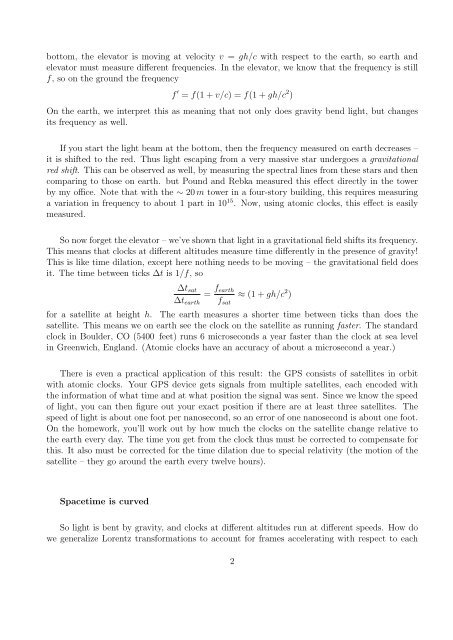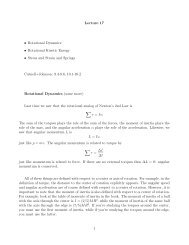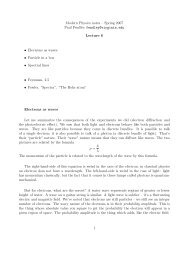Lecture 35 - Paul Fendley
Lecture 35 - Paul Fendley
Lecture 35 - Paul Fendley
You also want an ePaper? Increase the reach of your titles
YUMPU automatically turns print PDFs into web optimized ePapers that Google loves.
ottom, the elevator is moving at velocity v = gh/c with respect to the earth, so earth and<br />
elevator must measure different frequencies. In the elevator, we know that the frequency is still<br />
f, so on the ground the frequency<br />
f ′ = f(1 + v/c) = f(1 + gh/c 2 )<br />
On the earth, we interpret this as meaning that not only does gravity bend light, but changes<br />
its frequency as well.<br />
If you start the light beam at the bottom, then the frequency measured on earth decreases –<br />
it is shifted to the red. Thus light escaping from a very massive star undergoes a gravitational<br />
red shift. This can be observed as well, by measuring the spectral lines from these stars and then<br />
comparing to those on earth. but Pound and Rebka measured this effect directly in the tower<br />
by my office. Note that with the ∼ 20 m tower in a four-story building, this requires measuring<br />
a variation in frequency to about 1 part in 10 15 . Now, using atomic clocks, this effect is easily<br />
measured.<br />
So now forget the elevator – we’ve shown that light in a gravitational field shifts its frequency.<br />
This means that clocks at different altitudes measure time differently in the presence of gravity!<br />
This is like time dilation, except here nothing needs to be moving – the gravitational field does<br />
it. The time between ticks ∆t is 1/f, so<br />
∆t sat<br />
∆t earth<br />
= f earth<br />
f sat<br />
≈ (1 + gh/c 2 )<br />
for a satellite at height h. The earth measures a shorter time between ticks than does the<br />
satellite. This means we on earth see the clock on the satellite as running faster. The standard<br />
clock in Boulder, CO (5400 feet) runs 6 microseconds a year faster than the clock at sea level<br />
in Greenwich, England. (Atomic clocks have an accuracy of about a microsecond a year.)<br />
There is even a practical application of this result: the GPS consists of satellites in orbit<br />
with atomic clocks. Your GPS device gets signals from multiple satellites, each encoded with<br />
the information of what time and at what position the signal was sent. Since we know the speed<br />
of light, you can then figure out your exact position if there are at least three satellites. The<br />
speed of light is about one foot per nanosecond, so an error of one nanosecond is about one foot.<br />
On the homework, you’ll work out by how much the clocks on the satellite change relative to<br />
the earth every day. The time you get from the clock thus must be corrected to compensate for<br />
this. It also must be corrected for the time dilation due to special relativity (the motion of the<br />
satellite – they go around the earth every twelve hours).<br />
Spacetime is curved<br />
So light is bent by gravity, and clocks at different altitudes run at different speeds. How do<br />
we generalize Lorentz transformations to account for frames accelerating with respect to each<br />
2











